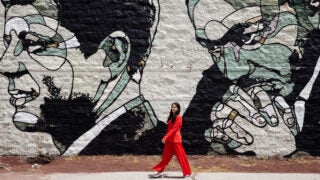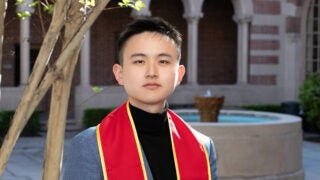Back to our roots: Native plants are growing again at USC, thanks to student-led effort
After sustainability-minded students replaced turf with native species, a university partnership flowered. Now, more water-sipping indigenous plants are getting started at test plots around campus.
Los Angeles is a city of transplants. Nowhere is that truer than on the ground, where turf more suited to the dewy clime of northern England covers many backyards and a good portion of the open space on USC’s University Park Campus.
The natives, though, are returning. In early November, thirsty turf along 34th Street on the north side of Birnkrant Residential College was removed. In its place was a test plot made up of eight varieties that might have grown here long before pavement. The plants — including Berkeley sedge, Douglas iris, evergreen currant, sugar bush and lemonade berry — are being closely watched and watered. Tianna Shaw-Wakeman, a psychology major who just finished her final semester before graduation, looks over them with care.
“Native gardens give us the whole picture,” she said. “It’s about sustaining life for birds, bees, insects, the food web, and it’s also about carbon, water and waste energy. USC has more green space than much of our surrounding community, and we have a responsibility to make sure that every plant we put in the ground has a distinct purpose and serves that community positively. I think we do that with natives better than anything else.”
Native plants at USC fit on campus, align well with sustainability goals
Shaw-Wakeman, who served as an Environmental Core (ECore) representative on USC’s Sustainability Steering Committee, put together meetings between Facilities Management and a horticulturist from the Natural History Museum of Los Angeles to talk about native planting late last year. Not long after, the test bed got a green light. Planting was headed up by landscape supervisor Erik Diaz, who’s seen natives thrive at Queens Court in front of Bing Theatre. ECore students replaced turf there with native plants four years ago.
“They had someone help them design the garden and pick the right plants. We just helped them with the tools they needed,” he said. “The partnership has grown from there. This whole initiative was started was by students who wanted to introduce California native species to the university with the long-term goal of having them in more places on campus,” Diaz said.
We have a responsibility to make sure that every plant we put in the ground has a distinct purpose.
Tianna Shaw-Wakeman
Those long-term goals align with other sustainability objectives set by USC President Carol L. Folt, which include carbon neutrality, a zero waste campus and increased use of solar panels.
Another test bed is being prepared in front of New North Residential College. Diaz and his team are working to get rid of stubborn weeds before the next natives are planted. Those plants, Shaw-Wakeman points out, can use as little as one-sixth of the water and support far more insects and animals than transplants.
“My hope is that I come back in five to ten years and I am embraced by all the natural landscapes Southern California has to offer right here on the USC campus,” she said. “That’s the dream.”



